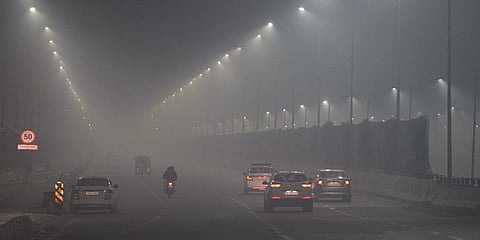

The past month of living in the gas chamber of the National Capital Region (NCR) has made one realise that the government and courts do not have the wherewithal to fight the monster of pollution.
Government’s main machinery – Commission for Air Quality Management (CAQM) – in its fight against pollution has proved to be a toothless tiger.
With no explicit powers to direct the state governments, its advisories have largely gone unhindered with the state governments finding ways and means bypass them.For example in the neighbouring districts of Ghaziabad and Gautam Buddha Nagar of Uttar Pradesh, the state governments have gone slow on penalising industries spreading pollution.
With no authority to prosecute the violators, CAQM is handicapped to get the policies and guidelines formulated by it to tackle pollution effectively implemented. This is not just limited to industrial pollution, regulations related to banning construction activities and regulating vehicular emissions too have not been enforced rigorously.
With its implementation at the ground level in the hands of the respective pollution control committees of the state government, the CAQM advisories have proved to be most ineffective resulting in the violators escaping accountability, leading to month-long reign of severe pollution, breathing poison. Pollution monitoring too has been inadequate.
The grid of air quality monitoring stations is scarce and haphazardly spread across the region, leading
to gaps in data collection. With a defective data at hand, it becomes increasingly challenging to attempt targeted interventions. With these monitoring stations again under the state government, their malfunction is often given to its irregular maintenance.
The poor state of air quality monitoring infrastructure is also attributable to the diversion of funds during the ‘non-pollution’ months.Political interference often leads to funds being diverted from environmental initiatives to projects that may help harvest a short term political gain. The CAQM in such situations has found itself to be hapless.
Last week addressing the issue, the National Green tribunal asked the CAQM to prepare a comprehensive plan for the entire NCR to deal with air pollution, after observing that some of the measures taken so far have been “knee-jerk” actions. “Because of rains, air quality may have improved. Now that the parali (stubble burning) issue is not there, why should it (AQI) be so high? Secondly, what we feel is, to improve air quality in Delhi, action needs to be taken not only in Delhi, but all of NCR, and there needs to be a comprehensive plan for that… this is a knee-jerk action,” NGT chairperson Justice Prakash Shrivastava had observed during the hearing last week.
The court has said that why should there be need to even initiate GRAP 1 stage of emergency pollution control measures. The Graded Response Action Plan (GRAP) for Delhi-NCR, implemented by the Centre, categorizes actions into four stages: Stage 1 – Poor (AQI 201-300), Stage 2 – Very Poor (AQI 301-400), Stage 3 – Severe (AQI 401-450), and Stage 4 – Severe Plus (AQI above 450).
The AQI scale ranges from “good” (0-50) to “severe plus” (above 450). It was in this context that the bench articulated that a comprehensive prevention plan to uphold Delhi’s air quality at an acceptable level be prepared.
While the plans can be made and discussed and directions passed, the courts also have to realise that there is a lack of political will to implement these measures. The pollution control boards across the states are officered by people who look at it either as a ‘shunting’ assignment or the opportunity to milk the violators of pollution-control norms.
The courts should also devise a plan to have a body with some teeth to take on the polluting juggernauts. In the absence of the same, the feeling of déja vu which visited residents of the NCR in 2023, would again revisit them in 2024.
Sidharth Mishra
Author and president, Centre for Reforms,Development & Justice